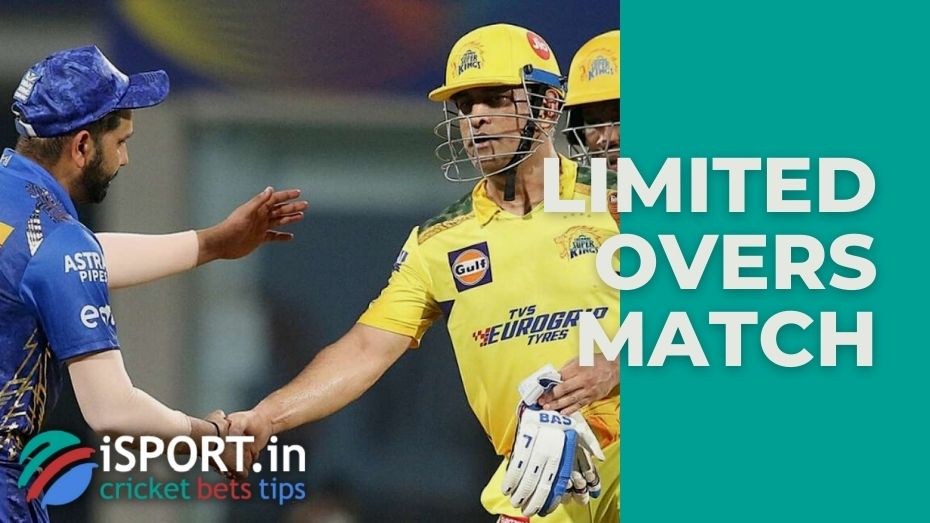Limited overs match

A cricket match that is played under the so-called one-day format is referred to as a limited overs match. This means that the contest cannot run for more than one day. In contrast to the traditional Test, the balls used in this competition are white rather than red. This is due to the fact that the team that smashes the second ball is often required to play under artificial lights.
The companies that make sports gear say that these two types of tools are not very different from each other. However, many players insist that an experienced bowler is able to give the ball a higher speed on the rebound, especially if the limited overs match is on a super hard surface.
Limited Overs Match: Core Concepts
There are several basic varieties of limited overs matches, in particular:
- List A (8 hours);
- T20 (3 hours);
- 100-ball (2.5 hours).
The name of such matches says it all: each side is only allowed to utilize a certain number of overs of six balls each, ranging from twenty to fifty. In practice, this implies that neither team is permitted to field fewer than five bowlers, each of whom will contribute approximately 20% of the total number of overs (with the exception of the United States, where four bowlers in the limited overs match are permitted to bowl five overs).
Each team gets the right to hit only once. On the other hand, there are circumstances in which it is allowed to implement the so-called Reserve day in order to decide the ultimate outcome of the game. Additionally, in some limited overs matches, the winner is determined by playing a Super Over that lasts for one inning after the regular over.
Historical Development of Limited Overs Cricket
During the All India Pooja Cricket Tournament, which took place in 1951, the first match to be played with limited overs was played. Klapan Tampuran, a former cricket player who played professionally, was the one who came up with the concept. Later on, it became popular in England, and eleven years later, the Midlands Knock-Out Cup, which was the first limited overs event held at the county level, was held there. The first-ever Gillette Cup was held a year later, when the Sussex squad emerged victorious over all other teams.
The organizers continued to experiment with the format, reducing the number of overs to sixty, and at the end of the 60s, the home One Day League was presented to the public, where the number of overs was only 40 (it is noteworthy that both the Cup and the League have not lost their popularity to this day). After some time had passed, the Royal London One Day Cup was included on the list.
Melbourne hosted the initial international limited overs event in 1971, and the inaugural World Cup was organized four years later. On the other hand, it took more than thirty years for the authorities in charge of sports to settle on another experiment: the Twenty20 tournament. In this competition, matches are restricted to twenty overs, which means that each side may only score a maximum of 120 goals. The new format immediately gained popularity, and as a result, significant modifications to the traditionally used rules were swiftly established in order to calculate a fair score in the event that a draw occurred.
Limited Overs Cricket: Modern Variations and International Competition
In recent years, a number of other limited overs match variations have emerged, despite the fact that the Test format is not seeing any decline in popularity. Therefore, in the year 2021, a game with 100 balls that lasted for two and a half hours was played for the very first time. However, it seems that this is not the maximum, since the T10 leagues arose in parallel, where the restricted overs match only lasts for ninety minutes. Also, the United Arab Emirates Cricket Council has announced the establishment of a new franchise league called 90 Bash. This league would only allow matches to be played with 90 balls.
One Day International matches, often known as ODIs. The so-called “day-night” structure is often used for these gatherings. To put it another way, the game is played in natural light for half of it and artificial light for the other half. For a long time, the number of overs that are played in a limited overs match has been a contentious issue. Nevertheless, in subsequent years, the number of overs was restricted to fifty. The Cricket World Cup is held once every four years, and all countries that have been granted test status as well as those who have successfully completed ICC qualifying are eligible to compete.
An initial group stage, a semi-final, and a final are the three stages that make up the tournament. The International Cricket Council has already decided where the final will take place. The International Cricket Council (ICC) Champions Trophy is contested in the intervals between championships. All teams who have a test status are automatically eligible to participate in the tournament. Additionally, each of the nations that are featured on this list is able to hold three-way one-day international tournaments, which need the participation of two teams that have been invited.
Home competition (List A). Compared to international matches, also known as one-day internationals (ODI), limited overs matches, which are played within the framework of these competitions, are one step down. List A tournament is conducted in practically every country where cricket is played. However, there are no limitations on the number of overs that may be played, and the number of overs that can be played by each team can range anywhere from forty to sixty.
The issue of keeping statistics was in limbo for a long time, until in 2006 the ICC announced a decision to unify the data based on the first-class competition. Thus, currently, the most status one-day tournaments, plus matches against guest test teams, fall into the List A lists:
- ODI;
- Other international Limited overs matches;
- One-day tournaments of the premier category;
- Official Test Team Away Matches against First Class Teams.
As a result, List A does not contain demonstration and friendly matches, as well as warm-up matches for the World Cup, other away matches (for instance, against first-class teams that do not compete in significant home tournaments of this category, particularly university ones), and world cup warm-up matches.
Australia. Limited overs matches are held in two popular tournaments – the Marsh One Day Cup and the KFC Twenty20 Big Bash. The first one, created in 1969, is represented by the following teams:
- the New South Wales Blues (New South Wales);
- the Victorian Bushrangers (Victoria);
- the Southern Redbacks (South Australia);
- the Tasmanian Tigers (Tasmania);
- the Queensland Bulls (Queensland);
- the Western Warriors (Western Australia).
The KFC Twenty20 Big Bash was introduced to the public in 2006. It is attended by the following teams representing the capitals of the Australian states:
- the Adelaide Strikers (Adelaide);
- the Brisbane Heat (Brisbane);
- the Hobart Hurricanes (Hobart);
- the Melbourne Renegades (Melbourne);
- the Melbourne Stars (Melbourne);
- the Perth Scorchers (Perth);
- the Sydney Sixers (Sydney);
- the Sydney Thunder (Sydney).
New Zealand. Since 1971, the Ford Trophy has been held here, in which six teams take part:
- the Northern Knights;
- the Auckland Aces;
- the Central Stags;
- the Wellington Firebirds;
- the Canterbury Wizards;
- the Otago Volts.
Bangladesh. The main List A competitions are called the Dhaka Premier Division Cricket League and have been held annually since the 2013-2014 season. The following teams are played in them:
- the Abahani Limited;
- the Agrani Bank Cricket Club;
- the Brothers Union;
- the Gazi Group Cricketers;
- the Kala Bagan Krira Chakra;
- the Khelaghar Samaj Kallyan Samity;
- the Legends of Rupganj;
- the Mohammedan Sporting Club;
- the Prime Bank Cricket Club;
- the Prime Doleshwar Sporting Club;
- the Sheikh Jamal Dhanmondi Club;
- the Shinepukur Cricket Club.
In addition, there is a separate T20 league in Bangladesh – the Bangladesh Premier League, in which seven teams have played since 2011:
- the Chittagong Vikings;
- the Comilla Victorians;
- the Dhaka Dynamites;
- the Khulna Titans;
- the Rajshahi Kings;
- the Rangpur Riders;
- the Sylhet Sixers.
England. There are three main competitions that are held simultaneously in the country that is the birthplace of cricket: the One-Day Cup (Limited overs matches are restricted to fifty overs), the Twenty20 Blast (which includes England and Wales), and the Hundred (which is a league with 100 balls). Every county has its own representative team, and teams from that county compete in all of the competitions that have been mentioned:
- Northern group of counties – the Birmingham Bears, the Derbyshire, the Falcons, the Durham Jets, the Lancashire Lightning, the Leicestershire Foxes, the Northamptonshire Steelbacks, the Nottinghamshire Outlaws, the Worcestershire Rapids, the Yorkshire Vikings.
- Southern group of counties – the Essex Eagles, the Glamorgan Dragons, the Gloucestershire, the Hampshire Royals, the Kent Spitfires, the Middlesex, the Somerset, the Surrey, the Sussex Sharks.
Nepal. There are four leagues operating here, within which limited overs matches are held:
- the Prime Minister One Day Cup;
- the Everest Premier League;
- the Dhangadhi Premier League;
- the Pokhara Premier League.
India. Cricket is very popular in this country, which is why fans have a wide range of competitions, which are held in a limited over format:
- the Ranji Trophy;
- the Deodhar Trophy;
- the NKP Salve Challenger Trophy;
- the Indian Cricket League (discontinued in 2009; replaced by the Indian Premier League).
Sri Lanka. The country’s premier limited overs tournament is the Premier Limited-Overs Tournament, with twenty teams from Badureliya Sports Club to Tamil Union Cricket and Athletic Club.
Pakistan. In addition to the Pakistan Super League, in which the Islamabad United, the Karachi Kings, the Lahore Qalandars, the Peshawar Zalmi, the Quetta Gladiators and the Multan Sultan are played, several home tournaments are held here every year, namely:
- the National Bank Cup, in which two leagues take part – Silver and Gold;
- the National Bank Patron’s Cup;
- the National Bank Twenty20 Cup.
South Africa. Limited overs matches in this country are held as part of the Momentum One Day Cup (formerly Benson & Hedges Series or Standard Bank Cup, where six franchise teams are played:
- the Dolphins;
- the Knights;
- the Lions;
- the Titans;
- the Warriors;
- the Cape Cobras.
West Indies. The following teams participate in the NAGICO Regional Super50 local league:
- the Barbados;
- the Canada;
- the Combined Campuses and Colleges cricket team;
- the Guyana;
- the Jamaica;
- the Trinidad and Tobago;
- the Leeward Islands;
- the United States;
- the West Indies B;
- the Windward Islands.
Interestingly, the limited overs match is more popular with modern viewers than traditional test games that last up to five days. And the point is not only in the time spent but also in the fact that the players are more likely to take risks and use more spectacular techniques in such matches.
